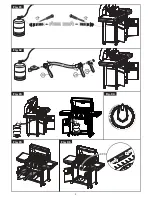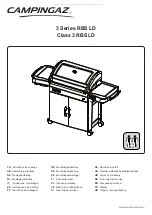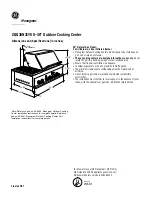
4
English
OPERATION
TRIGGER SWITCH
See Figure 3.
To turn the drill
ON
, depress the trigger switch.
To turn it
Off
, release the trigger switch.
VARIABLE SPEED
The variable speed trigger switch delivers higher speed
and torque with increased trigger pressure and lower
speed with decreased trigger pressure.
NOTE:
You might hear a whistling or ringing noise from
the switch during use. Do not be concerned; this is a
normal part of the switch function.
ROTATION SELECTOR
(fORWARD/REVERSE/CENTER LOCK)
See Figure 3.
The bit rotation is reversible and is controlled by a selector
located above the trigger switch. With the drill held in
normal operating position, the rotation selector should be
positioned to the left of the trigger switch for forward drilling.
The drilling direction is reversed when the selector is to the
right of the trigger switch.
Setting the trigger switch in the
Off
(center lock) position
helps reduce the possibility of accidental starting when not in
use.
CAUTION:
To prevent gear damage, always allow the chuck
to come to a complete stop before changing the
direction of rotation.
To stop the drill, release the trigger switch and allow the
chuck to come to a complete stop.
NOTE:
The drill will not run unless the rotation selector is
pushed fully to the left or right.
Avoid running the drill at low speeds for extended periods
of time. Running at low speeds under constant usage
may cause the drill to become overheated. If this occurs,
cool the drill by running it without a load and at full speed.
INTERNAL SPINDLE LOCK
The internal spindle lock allows the user single-handed
control of chuck adjustments and bit changes. Squeezing
the chuck body stops the chuck jaws from turning. For
bit changes and chuck adjustments, squeeze the chuck
body and turn.
KEyLESS CHUCK
See Figure 4.
The drill has a keyless chuck to tighten or release drill
bits in the chuck jaws. The arrows on the chuck indicate
which direction to rotate the chuck body in order to
LOCK
(tighten) or
UNLOCK
(release) the drill bit.
WARNING
Do not hold the chuck with one hand and use the
power of the drill to tighten the chuck jaws on the
drill bit. The chuck body could slip in your hand,
or your hand could slip and come in contact with
the rotating drill bit. This could cause an accident
resulting in serious personal injury.
TWO-SPEED GEAR TRAIN (HI-LO)
See Figure 5.
The drill has a two-speed gear train designed for drilling
or driving at
LO (1)
or
HI (2
) speeds. A slide switch is
located on top of the drill to select either
LO (1)
or
HI (2)
speed. When using drill in the
LO (1)
speed range, speed
will decrease and unit will have more power and torque.
When using drill in the
HI (2)
speed range, speed will
increase and unit will have less power and torque. Use
LO (1)
speed for high power and torque applications and
HI (2)
speed for fast drilling or driving applications.
NOTE:
If you have difficulty changing from one gear
range to the other, turn the chuck by hand until the gears
engage.
CAUTION:
Never change gears while the tool is running.
Failure to obey this caution could result in
serious damage to the drill.
QUICK MODE SELECTOR
See Figure 6.
The Quick Mode Selector allows you to quickly switch
from drill mode to drive mode.
In general, drill mode should be used for drilling and
other heavy duty applications. Drive mode should be
used for driving screws.percussion mode should be used
for impact drilling.
SELECTING DRIVE OR DRILL SETTING
See Figure 5-6.
Using the chart below, choose correct speed and mode
the type of bit, fastener, and material you will be using.
Choose your
APPLICATION
Choose the correct
SPEED: (1/LOW or 2/HIGH)
Choose the correct
MODE: (DRIVE, DRILL, OR
HAMMER)
Summary of Contents for LCDI1402
Page 1: ...14 4 VOLT COMPACT HAMMER DRILL DRIVER OWNER S OPERATING MANUAL LCDI1402...
Page 11: ......
Page 12: ...961067428 01...






























